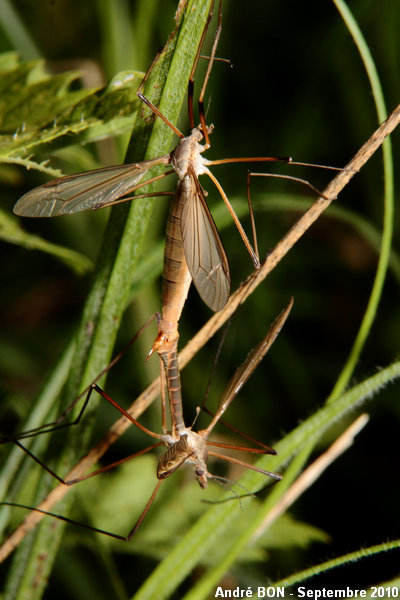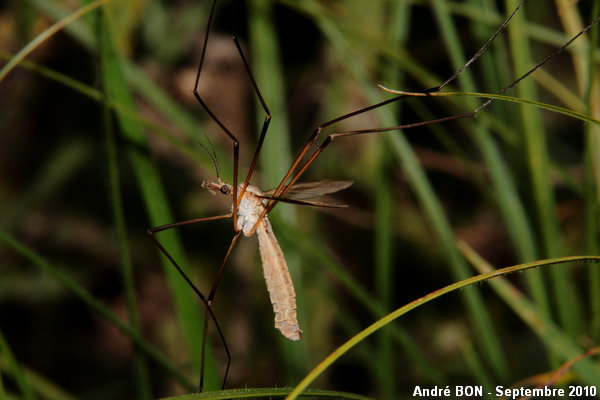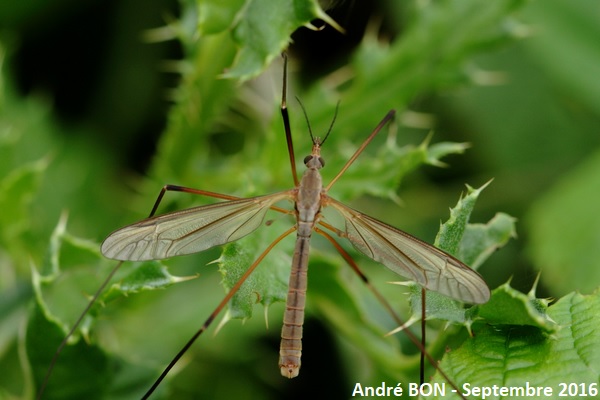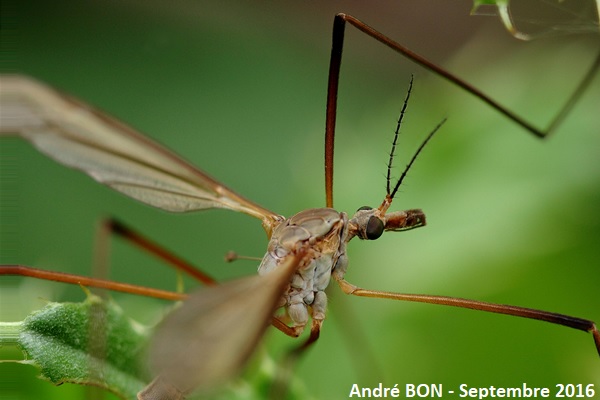



| Marsh Crane Fly (Tipula paludosa (Meigen, 1830)) |




|
|
Scientific name: Tipula paludosa (Meigen, 1830) Common name: Marsh Crane Fly French name: Tipule des prairies Order: Diptera Family: Tipulidae Wingspan : Body size: 20 to 25 mm for females, 16 to 18 mm for males. Biotope: Meadows and cultivated fields. Preference for damp habitats. Geographic area: Europe, North Africa, Asia, introduced to North America. Observation period : June to October in a single brood. |
Tipulidae, also called Crane Flies, are remarkable by their very long and fragile legs which can easily detach from the body. You can recognize the members of the Tipulidae family by the V-shape suture of the mesonotum, on the upper side of the thorax between the base of the wings, by their long snout and by they wing veins with two anal veins reaching the edge of the wing. The Crane flies of the Tipula genus are characterized by the sub-costal vein joining the radial vein (Tipulinae family), by the presence of a discal cell, by long legs and by thread-like antennae with 13 articles. There are 132 species of the Tipula genus in France, that's to say that it is very difficult to tell species apart. The Common Crane Fly (Tipula oleracea) is very similar. The two first antennal articles are yellowish on Tipula paludosa, Tipula oleracea has a least the three first antennal articles which are yellowish. The thorax is a greyish colour and shows darker longitudinal stripes. The wings show a dark brown front border followed by a blurred milky-white band. When resting, the wings are not held aligned above the body but are held open. Female Tipula paludosa 's abdomen is longer than the wings. This is the opposite on Tipula oleracea. The wings of Tipula oleracea are wider. Larvae, living on the ground, look like small greyish worms. They can cause important damages by attacking the base of plants. |
| [To know more about the Marsh Crane Fly] [Next picture] [Top] |

|
I have observed many Crane flies in this damp meadow. In this mating the female is located above. You can recognize it by the pointed abdomen tip. The species identification of Tipula paludosa is based on the wings. They are shorter than the abdomen length and show a thinner shape than those of Tipula oleracea. |
| [To know more about the Marsh Crane Fly] [Next picture] [Previous picture] [Top] |

|
The base of the antennae is only yellowish on the first article (and maybe on the second? This is better visible on the full size picture). |
| [To know more about the Marsh Crane Fly] [Next picture] [Previous picture] [Top] |

|
Here is a male. You can clearly see the dark front edge of the wing followed by a blurred milky-white band. |
| [To know more about the Marsh Crane Fly] [Previous picture] [Top] |

|
The species identification is confirmed by the yellowish colour of the two first antennal articles, the following one being black. |